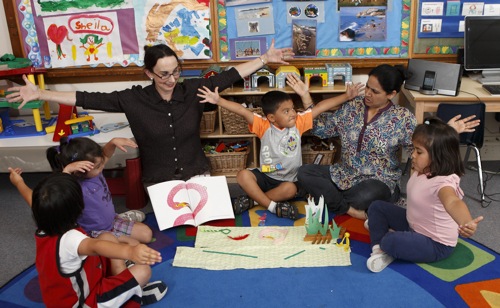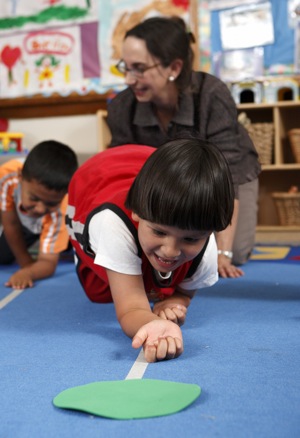If the TV hit show “Dancing with the Stars” were about real astronomical bodies, it would fit perfectly in the teaching/learning category known as STEAM. STEAM uses the arts, including performing arts like dance, to engage children in math and science in new and creative ways.
 Teaching Artists from the Wolf Trap Institute for Early Learning Through the Arts go into preschool and kindergarten classrooms to teach STEM concepts and skills. One activity they use starts out getting children moving or dancing freely to music. Then the educator adds an extra dimension—asking children to try different speeds, shapes, or patterns, or to use their motions to express something from the realm of science. The educator might ask, “How would you move if you were bubbles rising to the top of a glass of liquid, or a seed pod floating on the wind?”
Teaching Artists from the Wolf Trap Institute for Early Learning Through the Arts go into preschool and kindergarten classrooms to teach STEM concepts and skills. One activity they use starts out getting children moving or dancing freely to music. Then the educator adds an extra dimension—asking children to try different speeds, shapes, or patterns, or to use their motions to express something from the realm of science. The educator might ask, “How would you move if you were bubbles rising to the top of a glass of liquid, or a seed pod floating on the wind?”
“This kind of open-ended prompt gets children thinking and responding creatively, on both an aesthetic and scientific level,” explains Mimi Flaherty Willis, Wolf Trap’s Senior Director of Education. “The arts encourage creativity in all its forms, which can spill over to math and science learning.”
 Wolf Trap staff have created one particular workshop called “Dancing Like a Scientist” (content developed by Wolf Trap Master Teaching Artist Amanda Layton). This workshop teaches educators how movement that expresses concepts helps learners not only understand but retain those concepts. “Children learn the same way scientists learn, by testing their hypotheses over and over again. With the arts, this becomes hands-on, feet-on, whole body-on learning,” Willis observes.
Wolf Trap staff have created one particular workshop called “Dancing Like a Scientist” (content developed by Wolf Trap Master Teaching Artist Amanda Layton). This workshop teaches educators how movement that expresses concepts helps learners not only understand but retain those concepts. “Children learn the same way scientists learn, by testing their hypotheses over and over again. With the arts, this becomes hands-on, feet-on, whole body-on learning,” Willis observes.
In the arts, dance and music go together seamlessly, but music by itself can be a powerful teacher, giving learners a different way to acquire and use STEM knowledge. “We learn what children respond to,” Willis says. “Whether it’s recorded music, live performance, music on TV, on an iPhone, or adults singing with them—children respond, and the learning continues beyond the end of the song. If you can sing a simple song, you can teach STEM through the arts.”
Willis also encourages educators and parents to make STEM connections with drama and children’s literature. “Drama is the very core of how children play. By taking on roles, they learn about the world,” she notes, and this can include the scientific world as well. Willis recommends reading books about the arts with children—or any books that children love—and connecting those books to STEM. Suggestions are available on Wolf Trap’s website.
Whether STEM learning through the arts is formalized or incorporated into everyday activities, “Start early to give children many different ways to acquire and use knowledge,” Willis urges. “At the very same time they are blossoming in the arts, all this science and math learning can go on in tandem.”
The Wolf Trap Foundation for the Performing Arts launched its Early Childhood STEM Learning Through the Arts program in the fall of 2010. With support from a United States Department of Education Arts in Education Model Development and Dissemination grant, Wolf Trap is conducting a four-year research study of its STEM work in Fairfax County, Virginia public schools.
The program has also expanded to ten locations around the country thanks to support from the Northrop Grumman Foundation, bringingWolf Trap Teaching Artists into classrooms, providing professional development workshops for administrators, teachers and specialists, and involving parents and caregivers in special family workshops.
Photos: Scott Suchman
